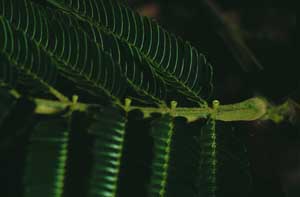|
|
 5 Acacia ruddaei DHJanzen100087.jpg high resolution
|
|
| Foliar nectaries on a non-ant-acacia leaf petiole and rachis (the portion of the leaf between the leaflet-bearing pinnnae). Foliar nectaries such as these and ecologically similar structures on the leaves (and buds, and fruits, and flower petals) of many species and families of plants have long been involved in a diffuse coevolutionary mutualism with ants (and probably parasitic wasps as well). The ants of many species(living in twigs, hollow trees, and the ground) visit the nectaries for the sugary liquid produced (exuded) and in the process forage (for prey) more on the foliage of the plant than they otherwise would. In many cases, the ants not only forage on this foliage, but territorially protect the nectaries and their vicinity from any (or most) intruders. Either activity results in reduced herbivory to the plant (and this can be shown experimentally in various ways), which is in turn the selective pressure for the evolution in the first place, and the development/elaboration of the nectar producing traits of the nectaries in the second place. All members of the genus Acacia (hundreds of species) in the neotropics and Africa have foliar nectaries (those in Australia sometimes do), so this is viewed as a genus-wide trait rather than one that evolved specifically in response to the obligatory ant-acacia interaction being described here. The same may be said for the thorns in Acacia, though there are many species of Acacia for which the stipules are not developed into thorns. The foliar nectaries of neotropical ant-acacias are particularly well developed in size and production (see below). | ||
back to lecture slides
or skip to: